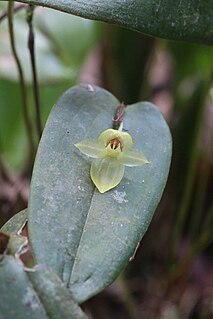
Pleurothallis is a genus of orchids commonly called bonnet orchids. The genus name is derived from the Greek word pleurothallos, meaning "riblike branches". This refers to the rib-like stems of many species. The genus is often abbreviated as "Pths" in horticultural trade.

Restrepia, abbreviated Rstp in horticultural trade, is a small genus of 49 orchids in the orchid family (Orchidaceae), closely related to Pleurothallis. Named in honor of Don Jose Restrepo, it tends to be more showy than most other Pleurothallids. They are found primarily at higher altitudes in the cool, damp montane forests of the Andes and Venezuela, with some into Central America up to southern Mexico.

Stelis, or leach orchids, is a large genus of orchids, with perhaps 500 species. The generic name Stelis is the Greek word for 'mistletoe', referring to the epiphytic habit of these species. These mainly epiphytic plants are widely distributed throughout much of South America, Central America, Mexico, the West Indies and Florida.

Masdevallia, abbreviated Masd in horticultural trade, is a large genus of flowering plants of the Pleurothallidinae, a subtribe of the orchid family (Orchidaceae). There are over 500 species, grouped into several subgenera. The genus is named for Jose Masdevall (?-1801), a physician and botanist in the court of Charles III of Spain.

The orchid genus Dracula, abbreviated as Drac in horticultural trade, consists of 118 species native to Mexico, Central America, Colombia, Ecuador and Peru. The name Dracula literally means "little dragon", an allusion to the mythical Count Dracula, a lead character in numerous vampire novels and films. The name was applied to the orchid because of the blood-red color of several of the species, and the strange aspect of the long spurs of the sepals. The plants were once included in the genus Masdevallia, but became a separate genus in 1978. This genus has been placed in the subtribe Pleurothallidinae.
Restrepia citrina is an orchid, close related to the pleurothallinids.
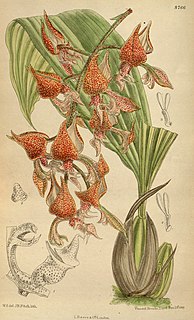
Gongora, abbreviated Gga in horticultural trade, is a member of the orchid family (Orchidaceae). It consists of 65 species known from Central America, Trinidad, and tropical South America, with most species found in Colombia. They grow in wide geographical range from wet forests at sea level to mountainous regions in the Andes, as high as 1,800 m.

Oncidium, abbreviated as Onc. in the horticultural trade, is a genus that contains about 330 species of orchids from the subtribe Oncidiinae of the orchid family (Orchidaceae). As presently conceived, it is distributed across much of South America, Central America, Mexico and the West Indies, with one species (O. ensatum) extending into Florida. Common names for plants in this genus include dancing-lady orchid and golden shower orchid.
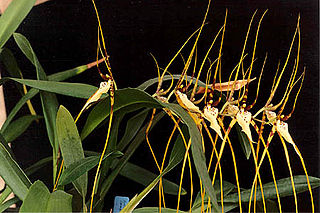
Brassia is a genus of orchids classified in the subtribe Oncidiinae. It is native to Mexico, Central America, the West Indies, and northern South America, with one species extending into Florida.

Epidendrum, abbreviated Epi in the horticultural trade, is a large neotropical genus of the orchid family. With more than 1,500 species, some authors describe it as a mega-genus. The genus name refers to its epiphytic growth habit.

Scaphosepalum is a genus of plants belonging to the family Orchidaceae. The species in this genus are mostly found in Central and South America, with one species extending into southern Mexico. In accordance with their genus name, many species in this genus produce unusual and distinctive flowers; some possessing cushion-like characteristics reminiscent of an African buffalo's horns, others possessing characteristics of snake fangs.

Barbosella is a genus of mostly creeping orchids. The genus has about 20 species, widespread across the West Indies and Latin America from Mexico and the Lesser Antilles to Argentina. Named after João Barbosa Rodrigues, an investigator of Brazilian orchids. They have solitary flowers with a unique lip base that works like a ball and socket.

Dryadella is a genus of miniature orchids, formerly included in the genus Masdevallia. Plants are typically composed of a tuft of leaves from 3 to 6 cm long. The small (1–2 cm) flowers are often conspicuously spotted, and are borne at the base of the leaves. There are about 60 species, distributed from southern Mexico to southern Brazil and northern Argentina. In cultivation many of the species seem to respond well to being grown on cork or treefern rather than in pots. The attractive species Dryadella edwallii, commonly known as 'Partridge in the Grass' can be easily grown into a spectacular specimen plant, full of flowers. The genus name of Dryadella refers to Dryad, a tree nymph or tree spirit in Greek mythology.
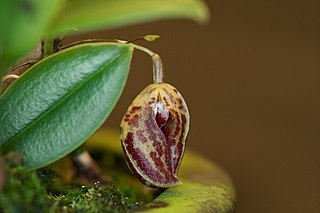
Phloeophila is a genus of orchids belonging to the tribe Pleurothallidinae. While an initial molecular phylogeny in 2013 suggested that the type species of the genus was nested within Pabstiella, further sampling showed that it in fact belongs to a unique clade distant from Pabstiella, forming the current basis of the genus.

Porroglossum is a genus of orchids native to the Andes of South America. The center of diversity lies in Ecuador, with many of the species endemic to that country, though others are found in Colombia, Venezuela, Peru, and Bolivia. This genus is abbreviated Prgm in horticultural trade.
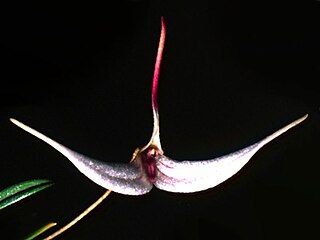
Trisetella is a genus of orchids, native to Central and South America. Twelve of the 23 currently known species are endemic to Ecuador. They bear small flowers with fused sepals and fused petals. The synsepal bears three hair-like tails, which is the namesake of Trisetella.
Carlyle August Luer was a botanist specializing in the Orchidaceae. His specialty interest was the Pleurothallidinae and allied species.

Dracula wallisii is a species of orchid belonging to the genus Dracula. The species is found at altitudes of 1,600 to 2,600 m in Cordillera Central, Colombia. It is a common species, with large flowers that are often highly variable in form.

Masdevallia unguentum was discovered in 2010 in the collection of Finca Dracula and is reported from Colombia. It is morphologically similar to Masdevallia marthae which was also discovered in cultivation without collection data but was later re-discovered in 1993 on the road to a television tower in the Department of Risaralda, Colombia Both are members of the subsection Saltatrices which is characterized by flowers with a tubular calyx.

Dracula simia, called also monkey orchid or the monkey-like Dracula, is an epiphytic orchid originally described in the genus Masdevallia, but later moved to the genus Dracula. The arrangement of column, petals and lip strongly resembles a monkey's face. The plant blooms at any season with several flowers on the inflorescence that open successively. Flowers are fragrant with the scent of a ripe orange.


















